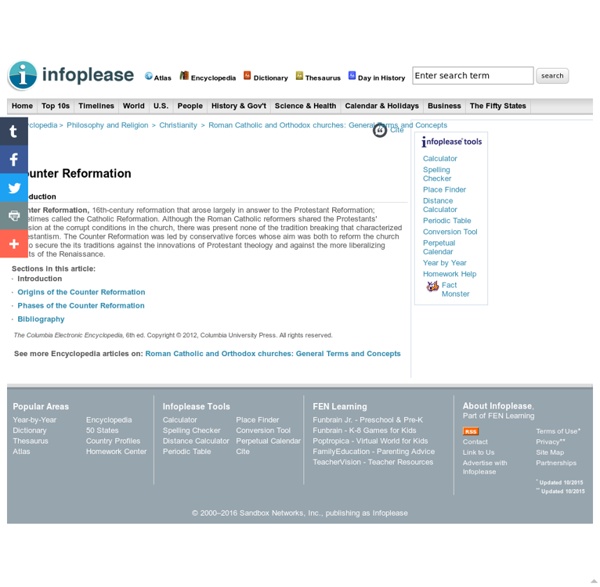



Counter-Reformation A copy of the Vulgate (the Latin edition of the Catholic Bible) printed in 1590, after many of the Council's reforms had begun to take place in Catholic worship. The Counter-Reformation (also the Catholic Revival[1] or Catholic Reformation) was the period of Catholic revival beginning with the Council of Trent (1545–1563) and ending at the close of the Thirty Years' War (1648), and was initiated in response to the Protestant Reformation. The Counter-Reformation was a comprehensive effort composed of four major elements: Ecclesiastical or structural reconfigurationReligious ordersSpiritual movementsPolitical dimensions Council of Trent[edit] A session of the Council of Trent, from an engraving. Pope Paul III (1534–1549) initiated the Council of Trent (1545–1563), a commission of cardinals tasked with institutional reform, addressing contentious issues such as corrupt bishops and priests, indulgences, and other financial abuses. Religious orders[edit] Politics: The Netherlands[edit]
"Rome, the Renaissance and Counter Reformation" EtruscansAncient Rome Medieval Rome RenaissanceBaroqueModern Rome The reaction of Pope Paul III (1534 - 1549, Alessandro Farnese) to the Protestant reform was to summon the council of Trent (1545-1563) and the Counter-Reformation. The most vividly remembered result is the Holy Inquisition which had begun in Spain and which the church extended to other countries. The objective of the Counter-Reformation was to use moral persuasion and the Holy Inquisition to minimise the effects of the (northern) reformers in an attempt to maintain unity of faith and of the Catholic church. Nevertheless the Reformist movement gained the support of many national states of northern Europe which were keen to challenge the political strength and material wealth of the Roman church. The church employed the newly founded Jesuit order as a tool to stem heresy through moral persuasion and teaching as well as a missionary vehicle aimed at Christianisation of the New World. Food for thought…..
The European Renaissance and Reformation: · Humanism: the focus of the Renaissance was the notion that Human beings were talented, and had the potential for great interests, achievements and capabilities. Zeal was established to recover the talented aspects of our past. The revival was interested in focusing on the Greco-Roman tradition of the past. · Pope Nicholas V: established a repository at the Vatican library that collected some 9000 manuscripts. · Leonardo Bruni: Florentine rhetorician and historian developed Humanism as a term/philosophy. · Pico della Mirandola: wrote on the Dignity of Man, best represented the study of the classics to understand human nature. · Secularism: everything Medieval focused on the afterlife, whereas the Renaissance focused on the here and now…often relating to material things (those things often relating to religion.) Lorenzo Valla: wrote on pleasure, defended the pleasures of the senses as the highest good, and offered the doctrine for the period. Art and the Artist:
Essay on the The Renaissance and Reformation period The Renaissance was a period of rebirth and transition in Europe. It began in Italy around the thirteenth century and spread gradually to the north and west across Europe for the next two centuries. It was a time of vast growth in learning and culture. Through contacts with the Arab world, the Western world was rediscovering many long-lost classical writings of the Greeks and Romans. Islamic scholars had preserved many of the ancient writing, and European scholars retranslated them from the Arabic and shared them across Europe. The classical writings become very popular, and many of their teachings were imitated by the Europeans. The universities, which were first established during the late Middle Ages, were growing into a potent intellectual force. Universities also were developing in other areas of Europe, especially in Germany, as the orientation toward church-controlled education lessened and secular education grew. Europe also was making the transition to "modern times."
Counter-Reformation The Counter-Reformation was a movement within the Catholic Church to reform itself in the wake of the Protestant Reformation. The term, "Counter-Reformation," was still unknown in the sixteenth and seventeenth centuries and was coined later by non-Catholic historians to denote a Catholic reaction to the Reformation. Thus, it carries a defensive and even negative tone. In the twentieth century, therefore, an alternative term, "Catholic Reformation," was used by scholars such as John C. Olin to assert the independent origins of spiritual and ecclesiastical reform in the pre-Tridentine era as a movement from which emerged two active, much more visible, yet separate, movements: Protestant and Catholic Reformations.[1] The Counter-Reformation, or the Catholic Reformation, was comprehensive. The Counter-Reformation was very successful in building the Church in South America and Asia mainly through the missionary work of Jesuits. Historical background Three main instruments The Council of Trent
J S Bach 2 The Plight of the Musician From the Reformation to the Enlightenment, musicians who participated in the liturgies of the deviating factions of a once unified western Christianity often found themselves on the front lines of the theological battlefields. Music operates at the level of the intimate spiritual life of the individual: was it not over this foundling that all the custody disputes were being waged ? As each new hurricane blast of the Reformation sent tidal waves rolling into the churches, courts and households of Europe, musicians and composers found themselves persecuted, ruined, dispossessed, sent into exile or jailed. . " [ The Papal edicts of 1665, 1678 and 1692] were aimed at curbing a dual reality. Protestant reformers felt much the same way. Johann Sebastian Bach himself had to deal with disputes over the role of music in religious contexts every time he changed jobs, in Luneberg, Ohrdruf, Mulhausen, Arnstadt and Leipzig. This did not happen overnight. " J.S. .